NEW! The Gist (FREE) | E-BOOKS |
(Paper) MPPSC: Online Examination of State Engineering Service (Pre.) Exam - 2014 Second Paper (Civil Engineering )

(Paper) MPPSC: Online Examination of State Engineering Service (Pre.) Exam - 2014 Second Paper (Civil Engineering )

![]()
Q1 : Which of the following is not the displacement method?
A Equilibrium method
B Column analogy method
C Moment distribution method
D Kani’s method
Answer Key: B
Q2 : When a uniformly distributed load, shorter than the span of the girder, moves from left to right, then the conditions for maximum bending moment at a section is that
A The head of the load reaches the section.
B The tail of the load reaches the section.
C The load position should be such that the section divides it equally on both
side.
D The load position should be such that the section divides the load in the same
ratio as it divides the span
Answer Key: D
Q3 : In column analogy method, the area of an analogous column for a fixed beam of span L and flexural rigidity EI is taken as
A L/EI
B L/2EI
C L/4EI
D L/8EI
Answer Key: A
Q4 :
What is the degree of kinematic indeterminacy of the beam shown in
fig.1 above
A 2
B 3
C 5
D 9
Answer Key: C
Q5 : A fixed beam AB is subjected to a triangular load varying from zero at end A to W per unit length at end B. the ratio of fix end moments at A to B will be
A 1/2
B 2/3
C 4/9
D 1/4
Answer Key: B
Q6 : A symmetrical two-hinged parabolic arch when subjected to a uniformly distributed load on the entire horizontal span, is ubject to
A Radial shear alone
B Normal thrust alone
C Normal thrust and bending moment
D Normal thrust, radial shear and bending moment
Answer Key: B
7 : A three hinged symmetric parabolic arch of span 20 meters and rise 5 meters is hinged at the crown and springing. It upports a uniformly distributed load of 2 tonnes per meter run of the span. The horizontal thrust in tonnes at each of the springing is
A 8
B 16
C 20
D Zero
Answer Key: C
Q8 : A simply supported beam of length L is subject to two point loads, each of P unit, at A and B equidistant from supports. Select the correct statement
A There will be no shear force between A and B and no bending moment between
A and B.
B There will be no shear force between A and B, but there will be uniform
bending moment between A and B.
C There will be uniform shear force between A and B, but bending moment will
gradually increase to maximum up to mid point of A and B.
D There will be uniform shear force between A and B, with maximum bending moment
at A and B with gradual decrease to zero at mid point of A and B.
Answer Key: B
Q9 : In an I-section, shear force is shared
A Mostly by web
B Mostly by flanges
C Uniformly by entire section
D Proportional to the respective areas of web and flanges.
Answer Key: A
Q10 : A member which is subjected to reversible tensile or compressive stresses may fail at stresses may fail at stresses lower than the ultimate stresses of the material. This property of metal is called
A Plasticity of the metal
B Workability of the metal
C Fatigue of the metal
D Creep of the metal
Answer Key: C
Q11 : If all the dimensions of a prismatic bar are increases in the proportion n:1, the proportion with which the maximum stress produced in the bar by its own weight will change by
A 1:n2
B 1:n
C
![]() :1
:1
D n:1
Answer Key: D
Q12 : In limit state design, under – reinforced section is one in which
A Tensile strain in steel reaches yield value while maximum compressive
strain in concrete is less than its ultimate crushing strain.
B Maximum tensile stress in steel reaches its permissible value while maximum
compressive stress in concrete is less than its permissible value.
C Maximum compressive strain in concrete reaches the ultimate crushing value
while tensile strain in steel is less than its yield value.
D Maximum compressive stress in concrete reaches its permissible value while
tensile stress in steel is less than its permissible value.
Answer Key: A
Q13 : In reinforced concrete, pedestal is defined as a compression member, whose effective length does not exceed its least lateral dimension by
A 3 times
B 8 times
C 12 times
D 16 times
Answer Key: A
Q14 : For RCC bridges, the smallest span beyond which the impact factor is same for class A or B or AA and 70R loading (wheeled vehicles) is
A 9 m
B 12m
C 36 m
D 45 m
Answer Key: B
Q15 : The purpose of lateral ties in short RCC column is to
A Increase the load carrying capacity of the columns
B Facilitate compaction of concrete
C Maintain plumb while construction
D Avoid buckling of longitudinal bars
Answer Key: D
Q16 : The side face reinforcement, if required, in a T-beam will be
A 0.1% of the web area
B 0.15% of the web area
C 0.2% to 0.3% of the web area depending upon the breadth of the web
D 0.1% of the total longitudinal reinforcement
Answer Key: A
Q17 : Match list A with list B and select the correct answer using the codes given below the list.
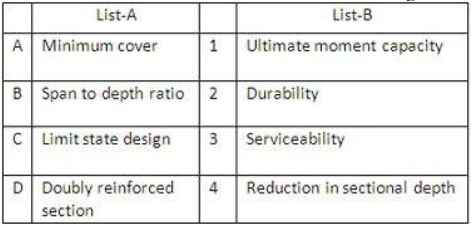
A
..gif)
B![]()
C![]()
D.gif)
Answer Key: D
Q18 : The loss of prestress due to shrinkage of concrete is the product of
A Modular ratio and percentage of steel
B Modulus of elasticity of concrete and shrinkage of concrete
C Modulus of elasticity of steel and shrinkage of concrete
D Modular ratio and modulus of elasticity of steel.
Answer Key: C
Q19 : Prestressed concrete is more desirable in case of
A Cylindrical pipes subjected to internal fluid pressure
B Cylindrical pipes subjected to external fluid pressure
C Cylindrical pipes subjected to equal internal and external fluid pressures
D Cylindrical pipes subjected to end pressures
Answer Key: A
Q20 : The applicable IS code for RCC liquid retaining structure is
A IS:456
B IS:800
C IS:1893
D IS:3370
Answer Key: D
Q21 : Drops in flat slabs are provided to resist
A Bending moment
B Thrust
C Shear
D torsion
Answer Key: C
Q22 : Increase in the fineness of cement results in
A Increase in the rate of heat of hydration without changing the total amount of
heat liberated
B Decrease in the rate of heat of hydration without changing the total amount of
heat liberated
C Increase in the rate of heat of hydration with an increase in the total amount
of heat liberated
D Decrease in the rate of heat of hydration with a reduced amount of heat
liberated
Answer Key: A
Q23 : As per IS:800, the maximum deflection in a beam should not exceed
A L/180
B L/250
C L/325
D L/360
Answer Key: C
Q24 : By providing sufficient edge distance, which of the following failures of riveted joint can be avoided
A Tension failure of the plate
B Shear failure of the rivet
C Shear failure of the plate
D Crushing failure of the rivet
Answer Key: C
Q25 : Gantry girders are designed to resist
A Lateral loads
B Longitudinal and vertical loads
C Longitudinal, lateral and vertical loads
D Longitudinal and lateral loads
Answer Key: C
Q26 : Match list I with list II and select correct answer using the loads given below the list
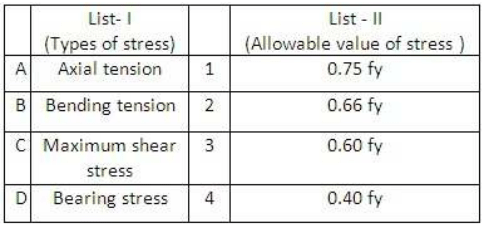
(fy=minimum field stress of steel)
A.gif)
B.gif)
C.gif)
D.gif)
Answer Key: BQ27
Q27: For an I beam the shape factor is 1.12 the factor of safety in bending is 1.5. IF the allowable stress is increased by 20% for the wind and earthquake loads, then the load factor is
A 1.10
B 1.25
C 1.35
D 1.40
Answer Key: D
Q28 : The channels or angles in the compression chords of the steel truss girder bridges are turned outward in order to increase
A Cross-sectional area
B Sectional modulus
C Torsional constant
D Radius of gyration
Answer Key: D
Q29 : Match list I (deflection) with list II (expression) for deflection in different types of beams of span ‘l’ subjected to total load ’w’ and select the correct answer using the loads given below the lists:
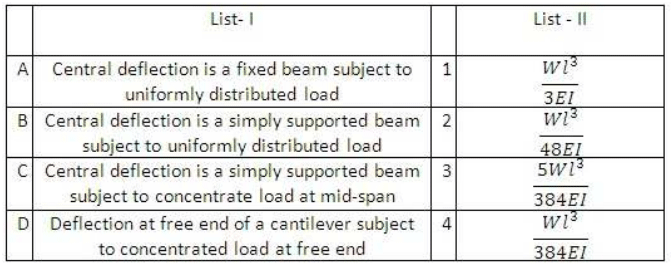
A.gif)
B![]()
C.gif)
D.gif)
Answer Key: D
Q30 : In a composite construction
A Interface slipping is prevented by using shear connector
B Differential shrinkage is overcome by using the same grade of concrete for
both the components.
C Precast member is always designed to carry the weight of in-situ concrete
without props.
D The in-situ concrete cannot be prestressed.
Answer Key: A
Q31 : For a standard 45o fillet weld, the ratio of size of fillet to throat thickness is
A 1:1
B 1:![]()
C
![]() :1
:1
D 2:1
Answer Key: C
Q32 : In PERT analysis, the time estimates of activities and probability of their occurrence follow
A Normal distribution curve
B Poisson’s distribution curve
C
![]() – distribution curve
– distribution curve
D Binomial distribution curve
Answer Key: C
Q33 : If the optimistic time, most likely time and pessimistic time or activity A are 4, 6 and 8 weeks. Respectively and for activity B are 5, 5.5 and 9 weeks respectively, then
A Expected time of activity A is greater than the expected time of activity B
B Expected time of activity B is greater than the expected time of activity A
C Expected time of both activities A and B are same
D Data too inadequate to compute expected times of activities
Answer Key: C
Q34 : The reduction in project time normally results in
A Decrease in the direct cost and increase in the indirect cost
B Increase in the direct cost and decrease in the indirect cost
C Increase in both direct and indirect costs
D Decrease in both direct and indirect costs
Answer Key: B
Q35 : Mobilisation advance up to certain percentage of cost of work is given to a contractor
A On commencement of work at site for payment of loan taken by him
B For the purchase of construction materials
C For the payment of advances to labour and other staff
D For all activities required to start the work at site on finalization of the
contract documents
Answer Key: D
Q36 : Cost – benefit studies are essential to
A Assess the total cost of the work
B Ascertain the relevant escalation in price
C Monitor the expenditure
D Evaluate the viability and worthwhileness of taking up the project
Answer Key: D
Q37 : If the expected time for completion of a project is 10 days with a standard deviation of 2 days, the anticipated time of completion of the project with 99.9% probability is
A 16 days
B 12 days
C 10 days
D 6 days
Answer Key: A
Q38 : With the usual notations, capital recovery factor is given by
A.gif)
B.gif)
C.gif)
D![]()
Answer Key: A
Q39 : A burst event is represented by
A.gif)
B.gif)
C.gif)
D.gif)
Answer Key: B
Q40 : Which of the following is not the function of fastner?
A To hold rails in proper positions
B To join rail with sleepers
C To join adjacent rails
D To join sleeper with ballast
Answer Key: D
Q41 : Geometric design of highway includes (i) Horizontal alignment, (ii) vertical alignment, (iii) arbouri-culture, (iv) Cross section.
Choose the right combination.
A (i), (ii) and (iii)
B (i), (ii) and (iv)
C (ii), (iii) and (iv)
D (i), (ii), (iii) and (iv)
Answer Key: B
Q42 : On a circular curve, the rate of super elevation is ‘e’ while negotiating the curve, vehicle comes a stop. It was observed that the stopped vehicle is sliding inwards in radial direction. If the coefficient of friction is ‘f’ which of the following is true?
A e > f
B e < f
C e < 2f
D None of these is correct
Answer Key: A
Q43 : Three runways are constructed parallel to each other at an angle of 260o with respect to magnetic north. A pilot is landing from east side while heading west. Which of the following best represents runway designations as seen by pilot (from leftmost to rightmost)
A 26L, 26C, 26R
B 26R, 26C, 26L
C 8L, 8C, 8R
D 8R, 8C, 8L
Answer Key: A
Q44 : Stripping of asphalt pavement is primarily due to
A Excessive asphalt content in mixture
B Moisture damage
C Fatigue damage
D Use of less tougher aggregate
Answer Key: B
Q45 : Dowel bars in concrete pavement are placed
A Along 45o
to direction of traffic
B Perpendicular to direction of traffic
C Along direction of traffic
D Can be placed in any direction
Answer Key: C
Q46 : The number of potential conflict points at an intersection of two lane national highway with another two-lane national highway (assuming both are two-way) is
A 8
B 16
C 24
D 32
Answer Key: C
Q47 : The ruling design speed on a national highway in plain terrain as per IRC recommendation is
A 80 kmph
B 100 kmph
C 120 kmph
D 150 kmph
Answer Key: B
Q48 : Rapid curing cutback bitumen is produced by blending bitumen with
A Petrol
B Diesel
C Benzene
D Kerosene
Answer Key: A
Q49 : Match list I with list II and select the correct answer using the codes given below the lists

A
![]()
B![]()
C![]()
D![]()
Answer Key: D
Q50 : Temperature variations affect the
A Biological activity of bacteria in sewage
B Viscosity of sewage
C Solubility of gases in sewage
D All options are correct
Answer Key: D
Q51 : A 25 ml sample was diluted to 250 ml with odourless distilled water so that the odour of the sample no longer perceivable. What was the Threshold odour number ?
A 11
B 10
C 25
D 05
Answer Key: B
Q52 : Why is proportional flow weir provided in a grit chamber ?
A To reduce the suspended solids entering the grit chamber
B to maintain constant flow velocity in the grit chamber over a certain depth
range
C To maintain constant flow depth in the grit chamber
D To allow sewage afresh into the grit chamber
Answer Key: B
Q53 : For a colony of 10,000 persons having sewage flow rate of 200 L/capita/day, BOD of applied sewage of 300 mg/L and organic loading of 300 kg/day/hectare, the area of an oxidation pond required for treating the sewage of the colony is
A 0.2 hectare
B 1 hectare
C 2 hectares
D 6 hectares
Answer Key: A
Q54 : Chlorine demand of water is equal to
A applied chlorine
B residual chlorine
C sum of applied and residual chlorine
D difference of applied and residual chlorine
Answer Key: D
Q55 : Which of these sewers are preferred for combined system of sewage?
A Circular Sewer
B Egg shaped Sewer
C Rectangular Sewer
D Trapezoidal Sewer
Answer Key: B
Q56 : Cleaning is done by
(i) scraping and removal of top layer in slow sand filter;
(ii) back washing in slow sand filters;
(iii) scraping and removal of top layer in rapid sand filter;
(iv) back washing in rapid sand filters.
The correct answer is
A (i) and (iv)
B (ii) and (iii)
C (ii) and (iv)
D (i) and (iii)
Answer Key: A
Q57 : Which one of the following gases plays a decisive role in affecting the climate of the earth ?
A Carbon dioxide
B Nitrogen
C Hydrogen
D Oxygen
Answer Key: A
Q58 : Refuse Derived fuel refers to
A segregated high calorific fraction of processed MSW
B segregated low calorific fraction of processed MSW
C Unsegregated processed MSW
D Unsegregated unprocessed MSW
Answer Key: A
Q59 : The bactaria which live and multiply with or without oxygen are called as
A Aerobic Bacteria
B Anaerobic Bacteria
C Facultative Bacteria
D Masophilic Bacteria
Answer Key: C
Q60 : Disappearance of pink colour of water of a well due to addition of KMnO4 indicates that water contained
A Acidity
B Alkalinity
C Turbidity
D Organic matter
Answer Key: D
Q61 : The ratio of the volume of voids to the total volume of soil is
A Void ratio
B Degree of saturation
C Air content
D Porosity
Answer Key: D
Q62 : Plastic charaeteristics of clays are due to
A Adsorbed water
B Free water
C Capillary water
D Excessive water
Answer Key: A
Q63 : The Pore water pressure in a capillary zone is
A Zero
B Positive
C Negative
D very low
Answer Key: C
Q64 : The permeability of soil varies
A Inversely as square of grain size
B as square of grain size
C as grain size
D inversely as void ratio
Answer Key: B
Q65 : The coefficient of curvature (Cc) of soil is
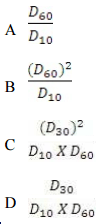
Answer Key: C
Q66 : A clay deposit suffers a total settlement of 5 cm with one-way drainage. With two-way drainage, the total settlement will be
A 10 cm
B 2.5 cm
C 20 cm
D 5 cm
Answer Key: D
Q67 : The compressibility of a field deposit is
A the same as that shown by laboratory sample
B somewhat greater than that shown by laboratory sample
C somewhat smaller than that shown by laboratory sample
D not at all related to that of a laboratory sample
Answer Key: B
Q68 : Vibratory roelers are best suited for compacting
A coarse sand and gravel
B silts
C clays
D organic soils
Answer Key: A
Q69 : For a standard compaction test, the mass of hammer and the drop of hammer are as follows
A 2.60 kg. and 450 mm
B 2.60 kg. and 310 mm
C 4.89 kg. and 310 mm
D 4.89 kg. and 450 mm
Answer Key: B
Q70 : For a saturated soil, skempton's B-parameter is
A nearly zero
B nearly 0.5
C nearly 1.0
D very high
Answer Key: C
Q71 : The inclination of failure plane behind a vertical wall in the passive pressure case is inclined to the horizontal at

Answer Key: A
Q72 : Identify the incorrect statement The stability of a slope is decreased by
A removal of a part of slope by excavation
B Shock caused by an earthqnake
C Pore water pressure in the soil
D Providing a berm at the toe
Answer Key: D
Q73 : In situ Vane shear test is used to measure shear strength of
A sandy soil
B stiff and fissured clays
C very soft and sensitive clays
D heterogeneous disintegrated rock
Answer Key: C
Q74 : The immediate settlement of a rigid footing is about ________ times the maximum settlement of an equal flexible footing
A 0.90
B 0.80
C 0.70
D 0.60
Answer Key: B
Q75 : The Permissible settlement is the maximum in the case of
A isolated footing on clay
B isolated fotting on sand
C raft on clay
D raft on sand
Answer Key: C
Q76 : Two footings, one circular and the other square, are founded in a pure clay. The diameter of the circular footing is the same as the side of the square footing. The ratio of their net ultimate bearing capacities
A is unity
B is 1.3
C is 1/1.3
D cannot be determined with the provided data
Answer Key: A
Q77 : The bearing capacity of soil supporting a footing of size 3m X 3m will not be affected by the presence of water table located at a depth below the base of footing of
A 1.0m
B 1.5m
C 3.0m
D 6.0m
Answer Key: C
Q78 : The most comprehensive of the pile driving formula is
A Engineering new formula
B Hiley's formula
C Static capacity formula
D Danish formula
Answer Key: B
Q79 : Lime stabilisation of clayey soil generally leads to
A decrease in shrinkage limit
B decrease in plastic limit
C increase in liquid limit
D flocculation of particles
Answer Key: D
Q80 : If the actual observed value of standard penetration resistance, N is greater than 15 in a fine sand layer below water table, then the equivalent penetration resistance will be
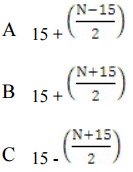
D cannot be determined with available data
Answer Key: A
Q81 :For a soil, field capacity and permanent wilting coefficient are 30% and 12% respectively. The available water in this case is
A 12%
B 18%
C 30%
D 42%
Answer Key: B
Q82 : A crop requires a total water depth of 90 cm for a base period of 120 days. The discharge required to irrigate the crop in 2880 hectares is
A 0.25 m3/s
B 1.0 m3/s
C 2.5 m3/s
D 10.0 m3/s
Answer Key: C
Q83 : A plot between rainfall intensity vs time is known as
A isohyet
B hyetograph
C hydrograph
D mass curve
Answer Key: B
Q84 : A raingauge recorded hourly ranifall as 5cm, 2cm, 4cm and 3cm for a four hour storm respectively. If the index was 3cm/hour, the total direct runoff from a catchment for the storm was
A 14 cm
B 12 cm
C 3 cm
D 2 cm
Answer Key: C
Q85 : Hydrograph is a plot of
A ranifall intensity vs time
B cummulative rainfall vs time
C runoff depth vs time
D discharge vs time
Answer Key: D
Q86 : A unit hydrograph has one unit of
A peak discharge
B rainfall duration
C direct runoff
D base time
Answer Key: C
Q87 : If two 2-hour unit hydrograph are staggered by 2 hours and added graphically, the resulting hydrograph will be
A 2- hour unit hydrograph
B 4- hour unit hydrograph
C 2- hour unit hydrograph with 2cm runoff
D 4- hour unit hydrograph with 2cm runoff
Answer Key: D
Q88 : The hydrologic flood routing uses
A continuity equation only
B momentum equation only
C both continuity and momentum equations
D energy equation only
Answer Key: A
Q89 : Steady pumping of a well at 314m3/hour produces drawdowns 4.0m and 2.0m at radial distances 2.0m and 20.0m respectively in a confined aquifer. The transmissivity of the aquifer is about
A 25.00m2 /hour
B 57.55m2/hour
C 28.78m2/hour
D 50.00m2/hour
Answer Key: B
Q90 : The useful storage is the volume of water stored in the reservoir between
A minimum pool level and maximum pool level
B minimum pool level and normal pool level
C river bed level and normal pool level
D river bed level and maximum pool level
Answer Key: B
Q91 : trap efficiency of a reservoir is a function of
A outflow/inflow ratio
B capacity/inflow ratio
C capacity/outflow ratio
D all of these is correct
Answer Key: B
Q92 for the upstseam face of an earthen dam the most adverse condition for stability of slope is :
A during construction
B steady seepage
C sudden drawdown
D during flood
Answer Key: C
Q93 :The base width of an elementary profile of a concrete gravity dam with no tension criteria and neglecting the uplift pressure is approximetely
A 65% of dam hight
B 75% of dam hight
C 85% of dam hight
D 95% of dam hight
Answer Key: A
Q94 : Which one of the following is not correct in reference to weir founded on alluvial soil
A a downstream pile is necessary to prevent piping
B in the downstream half of the floor the bligh theory under estimates the
uplift pressure
C launching apron protects the pile and impervious floor
D the thickness of impervious floor is computed based on the exit gradient
Answer Key: D
Q95 : Which one of the following is not a function of under sluices in a weir
A to control silt entry into the canal
B to pass the normal discharge without operating the shutter gates of the weir
C to regulate the supply of water entering into the canal
D to scour the silt deposited in the river bed above the approach channel
Answer Key: C
Q96 : An aqueduct is provided where
A canal bed level is above the HFL in river
B river bed level is above the FSL of canal
C canal bed level is in between the bed level and HFL of river
D river bed level is in between the bed level and FSL of canal
Answer Key: A
Q97 : To carry a discharge 100 m3 /s in a regime canal, the perimeter from lacey's theory is about
A 47.5 m
B 30.0 m
C 17.6 m
D 10.0 m
Answer Key: A
Q98 : The discharge of rigid module depends upon
A the water level in the distributary only
B the water level in the water course only
C the water levels both in the distributary and water course
D neither the water level in the distributary nor the water level in the water
course
Answer Key: D
Q99 : Which of the following canal structures is used to remove surplus water from a canal into a natural drain
A canal regulator
B canal fall
C canal outlet
D canal escape
Answer Key: D
Q100 : A pollulant entered into a confined aquifer of 5 m thick and porosity 25%. If the seepage discharge through the aquifer is 0.25 m2 /s, the travel time of pollutant for 100 m in the aquifer will be (in seconds)
A 20
B 400
C 500
D 2000
Answer Key: C
Printed Study Material for MPPSC
Courtesy : MPPSC

